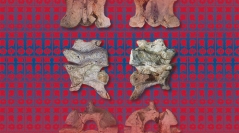

 Geodiversitas
43 (19) - Pages 683-689
Geodiversitas
43 (19) - Pages 683-689A new record of the genus Naja Laurenti, 1768 is described from the latest Miocene of Solnechnodolsk locality in Russia. It is assigned to N. romani (Hoffstetter, 1939), the largest European cobra, which disappeared in Europe before the end of the Miocene. The record of N. romani is the first evidence of the survival of cobras to the latest Miocene of Eastern Europe, which points to the existence of a Caucasian refugium during the late Miocene. The large size of the vertebra of the cobra from Solnechnodolsk indicates that it belonged to one of the largest specimens of this taxon. Naja romani from Solnechnodolsk represents the first record of cobras in Russia and the Northern Black Sea area, contributing to the knowledge of ancient biodiversity of the region and suggesting a wider range for the genus. Naja romani was a thermophilous snake that indicates a subtropical character of the Solnechnodolsk fauna.
Elapidae, cobra, Miocene, Neogene, Eastern Europe, new record